Experimental Study on a Passive Fuel Cell/Battery Hybrid Power System
Abstract
:1. Introduction
2. Experimental
2.1. Hybrid System Design
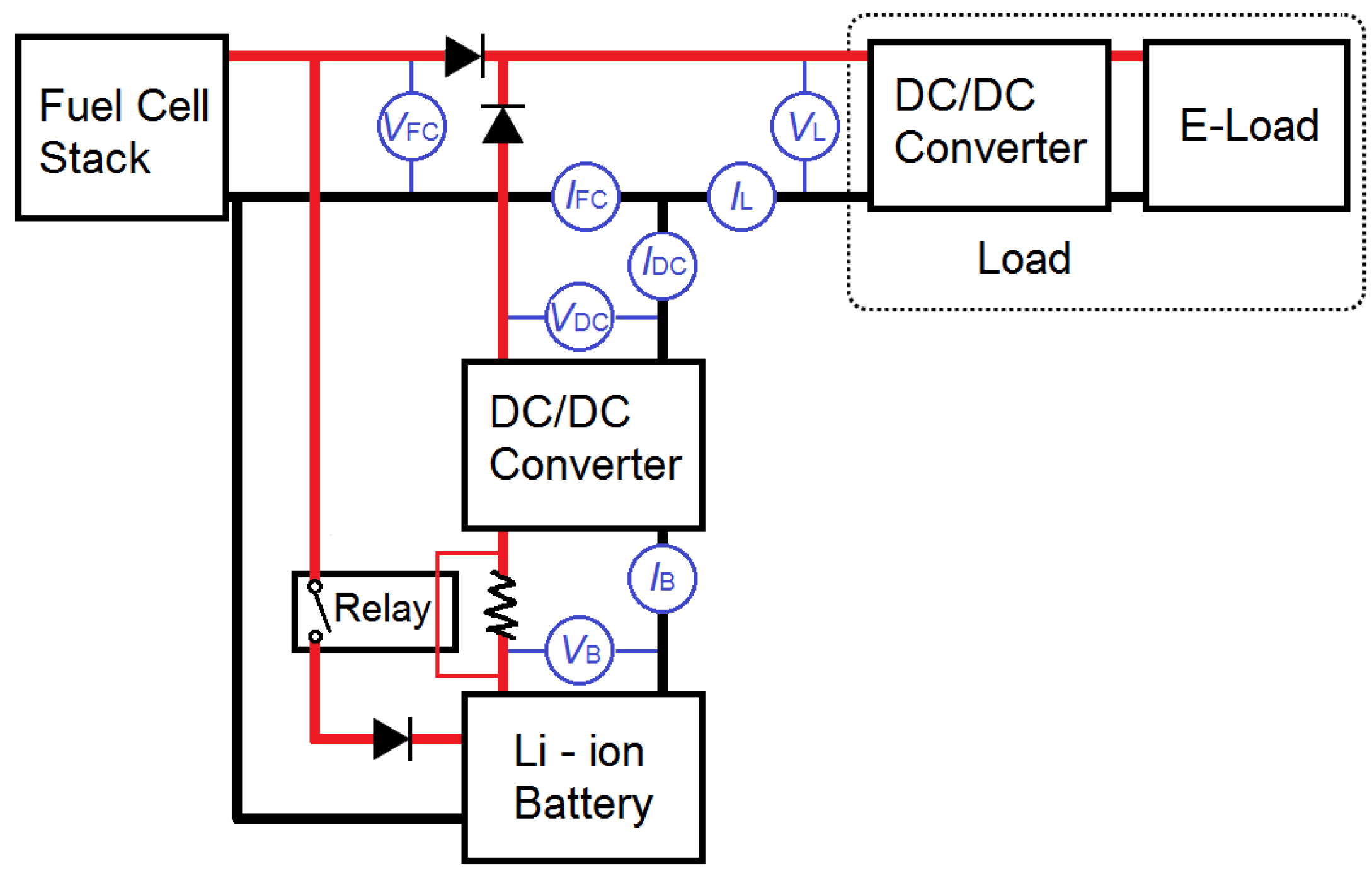
2.2. Experimental Procedure
3. Results and Discussion
3.1. Performances of Power Sources

3.2. Dynamic Response of the Hybrid Power System
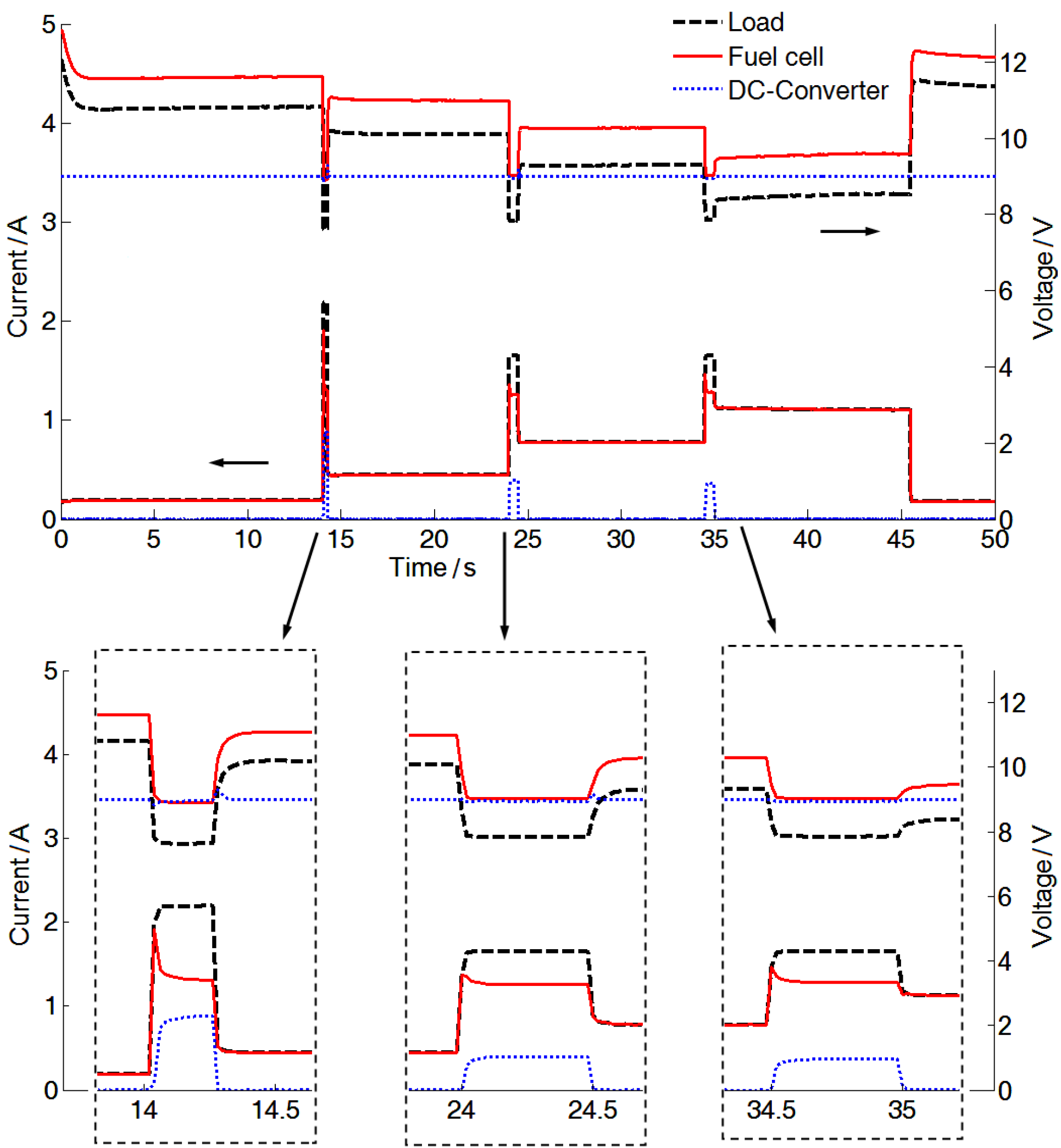
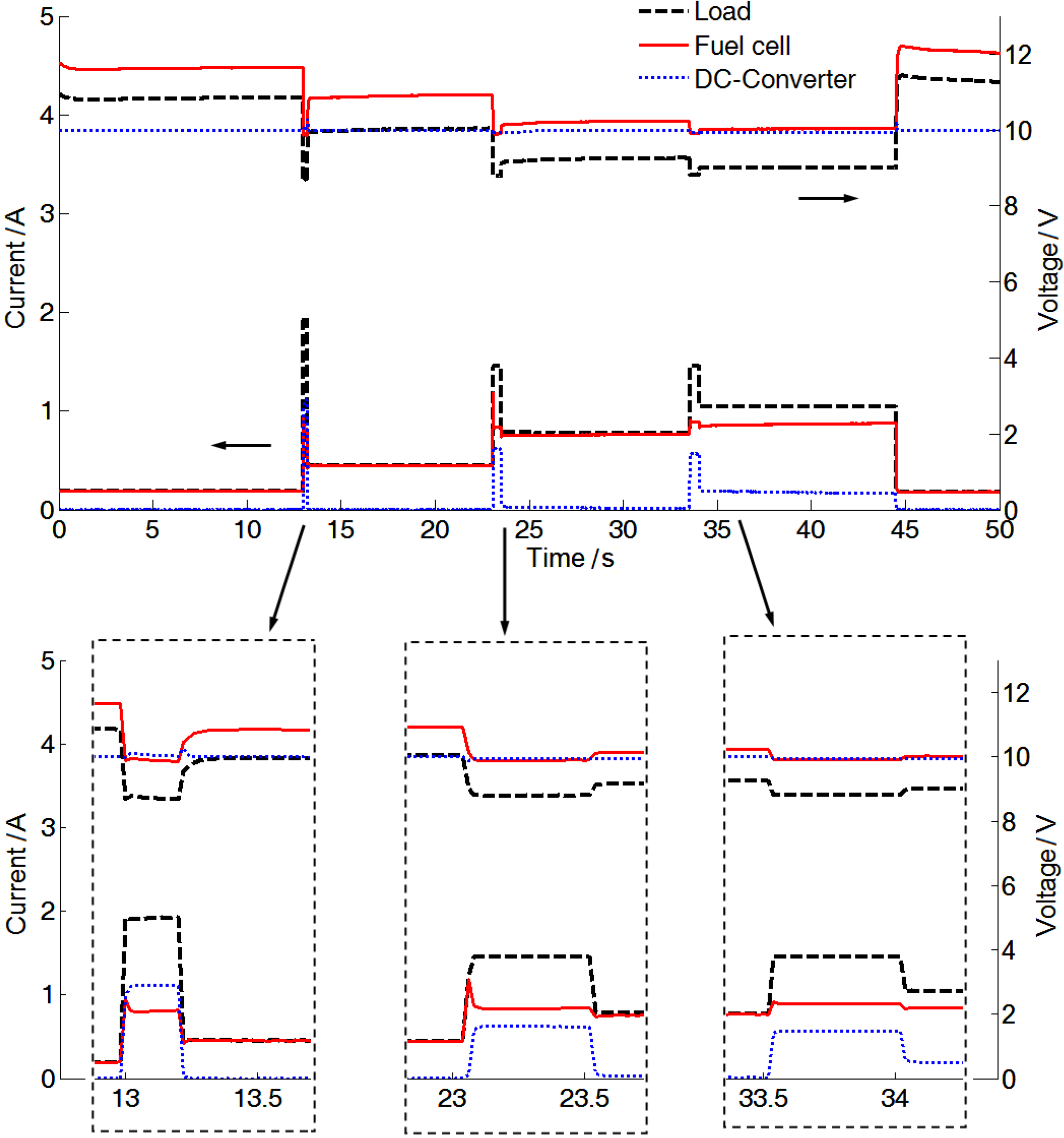
3.3. Analysis of Power Train Efficiency
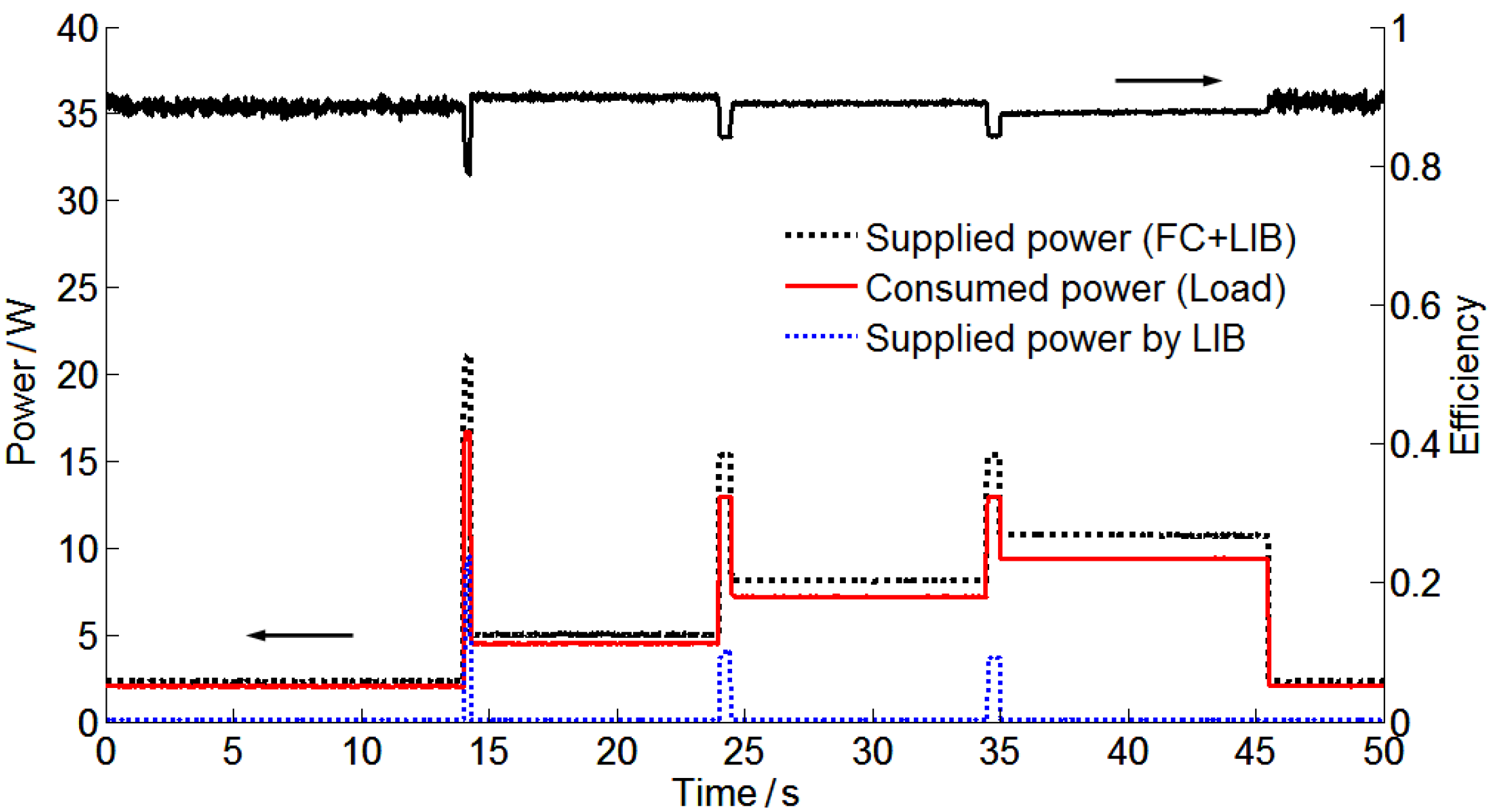
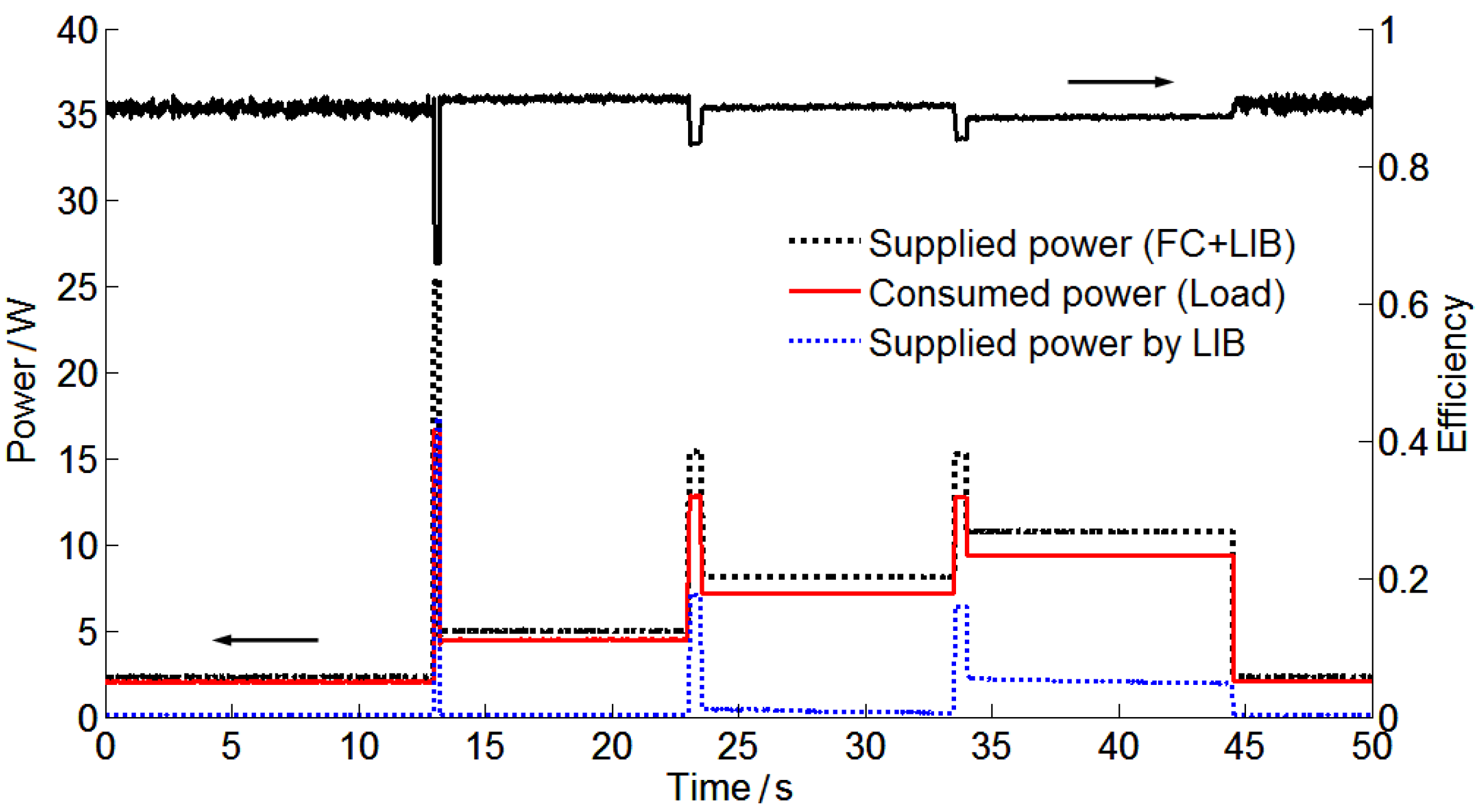
3.4. Charging Characteristics
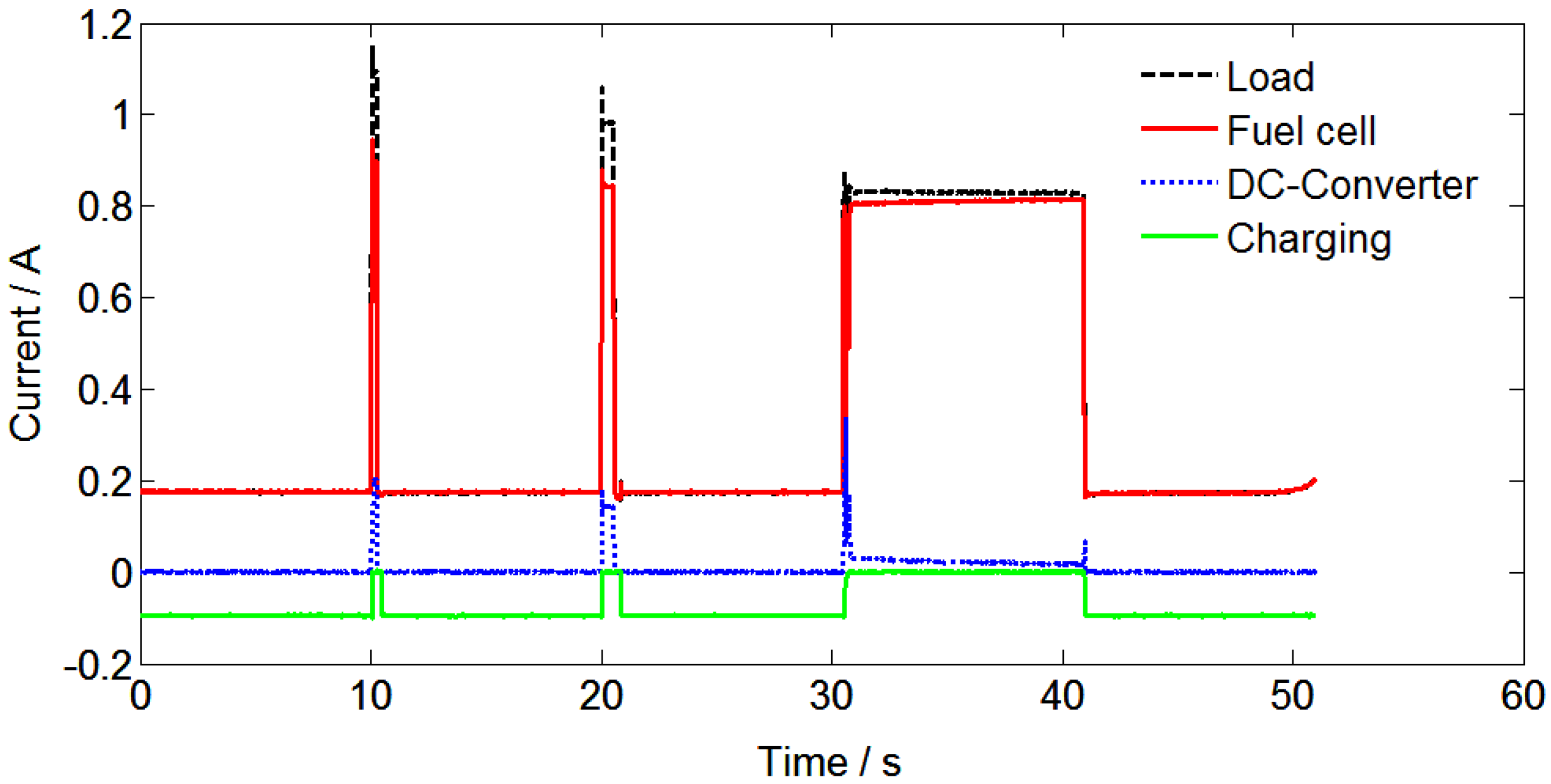
3.5. Design Procedure for the Hybrid Power System
- (1)
- Select the lowest limit of operating voltage, at which the fuel cell can satisfy the maximum continuous power requirement;
- (2)
- Determine the cell number and the active area according to Equation (1);
- (3)
- The output voltage of the DC/DC converter in the LIB line is adjusted to be the same with the lowest limit of the fuel cell voltage;
- (4)
- Measure the peak power demand during start-up and acceleration and then determine the capacity of the LIB.
4. Conclusions
- (1)
- During start-up and acceleration, the fuel cell stack cannot support the peak power demand. When the voltage of the fuel cell stack drops to the regulated LIB voltage, the battery compensates for the shortage of power.
- (2)
- The maximum power supply of the fuel cell stack can be determined by the output voltage of the LIB line. With the DC/DC converter in the LIB line, the lowest operating voltage of the fuel cell stack is constrained.
- (3)
- For a light duty vehicle, the major power loss source in this hybrid power system is the diodes. Choosing a low ratio of forward voltage drop to fuel cell voltage will improve the power train efficiency; however, for a high voltage system, the diode voltage drop is a minor issue.
- (4)
- A battery management system is required to monitor the state of health of the LIB for safety.
Acknowledgments
Conflicts of Interest
References
- Gao, L.; Jiang, Z.; Dougal, R.A. An actively controlled fuel cell/battery hybrid to meet pulsed power demands. J. Power Sources 2004, 130, 202–207. [Google Scholar] [CrossRef]
- Blackwelder, M.J.; Dougal, R.A. Power coordination in a fuel cell–battery hybrid power source using commercial power controller circuits. J. Power Sources 2004, 134, 139–147. [Google Scholar] [CrossRef]
- Jiang, Z.; Gao, L.; Blackwelder, M.J.; Dougal, R.A. Design and experimental tests of control strategies for active hybrid fuel cell/battery power sources. J. Power Sources 2004, 130, 163–171. [Google Scholar] [CrossRef]
- Moore, R.M.; Ramaswamy, S.; Cunningham, J.M.; Hauer, K.H. A dynamic simulation tool for the battery-hybrid hydrogen fuel cell vehicle. Fuel Cells 2006, 6, 387–402. [Google Scholar] [CrossRef]
- Zhao, H.; Burke, A.F. Fuel cell powered vehicles using supercapacitors-device characteristics, control strategies, and simulation results. Fuel Cells 2010, 10, 879–896. [Google Scholar] [CrossRef]
- Thounthong, P.; Raël, S.; Davat, B. Energy management of fuel cell/battery/supercapacitor hybrid power source for vehicle applications. J. Power Sources 2009, 193, 376–385. [Google Scholar] [CrossRef]
- Tang, Y.; Yuan, W.; Pan, M.; Wan, Z. Experimental investigation on the dynamic performance of a hybrid PEM fuel cell/battery system for lightweight electric vehicle application. Appl. Energy 2011, 88, 68–76. [Google Scholar] [CrossRef]
- Büchi, F.N.; Paganelli, G.; Dietrich, P.; Laurent, D.; Tsukada, A.; Varenne, P.; Delfino, A.; Kötz, R.; Freunberger, S.A.; Magne, P.-A.; et al. Consumption and efficiency of a passenger car with a hydrogen/oxygen PEFC based hybrid electric drivetrain. Fuel Cells 2007, 7, 329–335. [Google Scholar] [CrossRef]
- Sripakagorn, A.; Limwuthigraijirat, N. Experimental assessment of fuel cell/supercapacitor hybrid system for scooters. Int. J. Hydrog. Energy 2009, 34, 6036–6044. [Google Scholar] [CrossRef]
- Aso, S.; Kizaki, M.; Nonobe, Y. Development of Fuel Cell Hybrid Vehicles in Toyota. In Proceedings of the Power Conversion Conference (PCC), Nogoya, Japan, 2–5 April 2007; pp. 1606–1611.
- Bernard, J.; Hofer, M.; Hannesen, U.; Toth, A.; Tsukada, A.; Büchi, F.N.; Dietrich, P. Fuel cell/battery passive hybrid power source for electric powertrains. J. Power Sources 2011, 196, 5867–5872. [Google Scholar] [CrossRef]
- Keränen, T.M.; Karimäki, H.; Viitakangas, J.; Vallet, J.; Ihonen, J.; Hyötylä, P.; Uusalo, H.; Tingelöf, T. Development of integrated fuel cell hybrid power source for electric forklift. J. Power Sources 2011, 196, 9058–9068. [Google Scholar] [CrossRef]
- Nishizawa, A.; Kallo, J.; Garrot, O.; Weiss-Ungethüm, J. Fuel cell and Li-ion battery direct hybridization system for aircraft applications. J. Power Sources 2013, 222, 294–300. [Google Scholar] [CrossRef]
© 2013 by the authors; licensee MDPI, Basel, Switzerland. This article is an open access article distributed under the terms and conditions of the Creative Commons Attribution license (http://creativecommons.org/licenses/by/3.0/).
Share and Cite
Chen, Y.-S.; Lin, S.-M.; Hong, B.-S. Experimental Study on a Passive Fuel Cell/Battery Hybrid Power System. Energies 2013, 6, 6413-6422. https://doi.org/10.3390/en6126413
Chen Y-S, Lin S-M, Hong B-S. Experimental Study on a Passive Fuel Cell/Battery Hybrid Power System. Energies. 2013; 6(12):6413-6422. https://doi.org/10.3390/en6126413
Chicago/Turabian StyleChen, Yong-Song, Sheng-Miao Lin, and Boe-Shong Hong. 2013. "Experimental Study on a Passive Fuel Cell/Battery Hybrid Power System" Energies 6, no. 12: 6413-6422. https://doi.org/10.3390/en6126413




